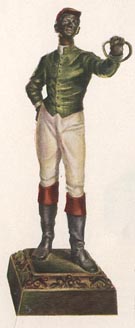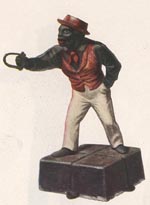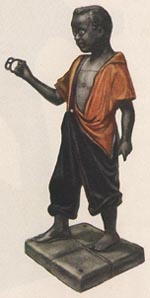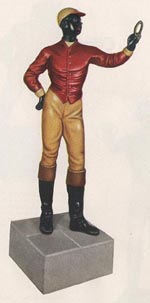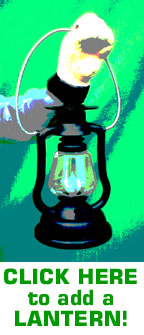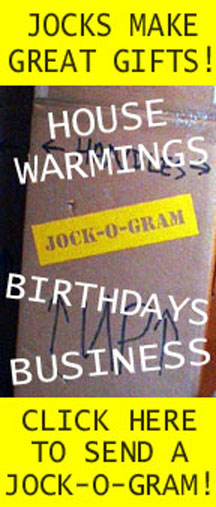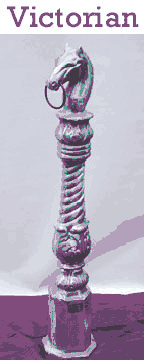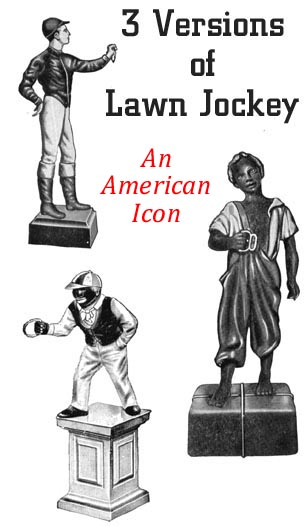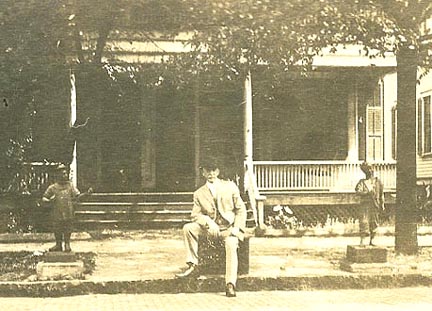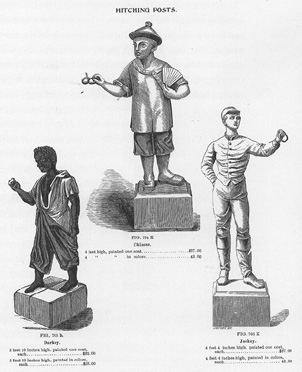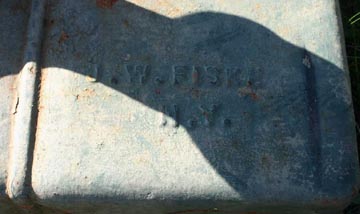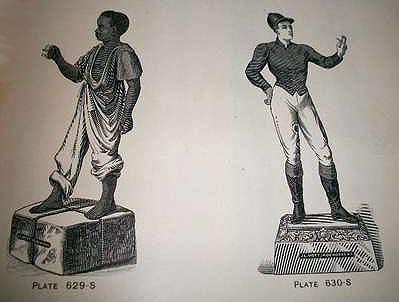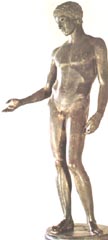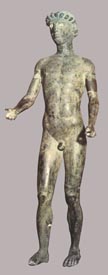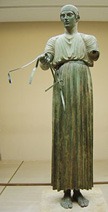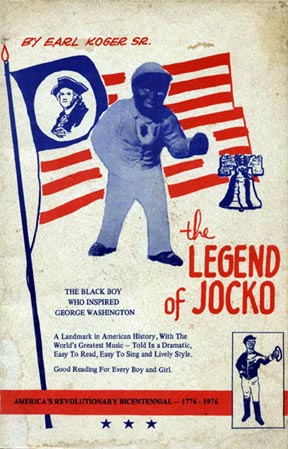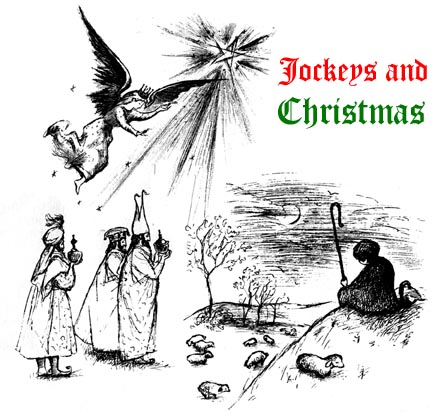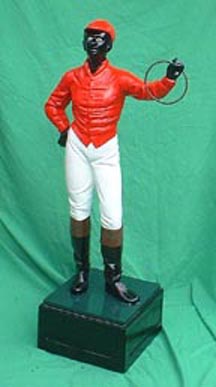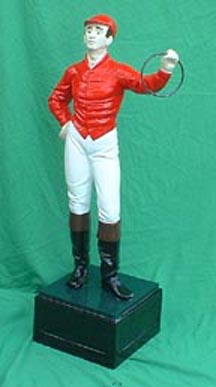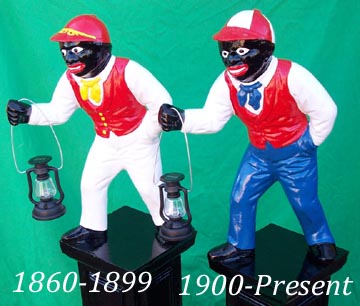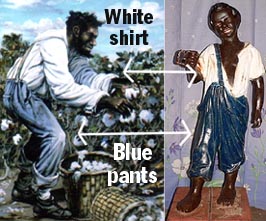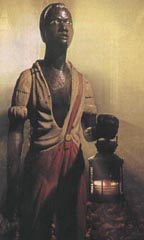
|
WEBSITE MENU
|
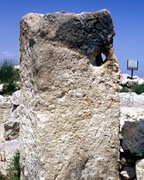 Ornate iron hitching posts-
How a unique American art form changed the world
Ornate iron hitching posts-
How a unique American art form changed the world
Horses were first domesticated for human travel use in the Eurasian Steppes(now Ukraine)
at approximately 4000 BC, and "old world" horse hitching posts remained the same for milleniums-
mostly looking like stone or wood monoliths featuring function over form. Shown above: Stone hitching post from 2000 BC in Megiddo, Israel.
America was called the "new world" in the 19th century.
Fancy cast iron hitch designs featuring ornate horse and human sculptures developed by American craftsmen were a unique "new world" art form.
From a cultural perspective, what makes Lawn Jockeys and Horsehead Hitching Posts prominent in world art history is
that they were only invented in the final century of the 6000 years of human travel on horseback- right before cars took over.
The aesthetic value of these American metal hitches is why they have long outlived their functionality for tying up horses.
Shown below: Antique cast iron horse hitching post from 1800 AD in USA.
|
|
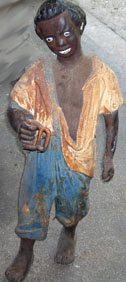 Lawn Jockeys, JW Fiske, and the Statue of Liberty
Lawn Jockeys, JW Fiske, and the Statue of Liberty
Above is an example of an original Faithful Groomsman statue manufactured by JW Fiske about 1865.
JW Fiske was the preeminent maker and retailer of architectural cast zinc and iron in New York City
from 1862-1900, and the Faithful Groomsman was in their catalog.
JW Fiske was also one of the only manufacturers to mark their statues.
Cast iron statue designs were stolen and duplicated by many companies during this Victorian period, the "golden age" of cast iron
and architectural metalwork. In fact, JW Fiske was known to even go over to europe to steal classical designs and duplicate
sculptures.
All of these details are important because it verifies that the Faithful Groomsman was a popular item and
the Jocko Graves story backing it up was well known, similar to a religious statue
like Mary or Saint Peter with a story behind it.
Another reason why the JW Fiske Faithful Groomsman statue is important is related to the Statue of Liberty,
which was completed in 1886. Frenchman Frederic Bartholdi was originally commissioned to design the statue in 1865 as a tribute
to America's independence, but the impetus was the abolition of slavery in 1865.
Original Statue of Liberty designs contained broken chains in Lady Liberty's hand and at her feet.
The original statue was made from black materials, which turned green over time- so the original black silhouette
of the Lady Liberty on a pedestal holding a light would have resembled the JW Fiske's Faithful Groomsman statue.
While visiting New York researching statue ideas, it is easy to see how Bartholdi could have gotten his slavery abolition idea for Lady Liberty from
the only original American "slave" statue from JW Fiske's architectural iron catalog. The ultimate symbolic irony
is George Washington's tribute to Jocko Graves during the battle for independence in 1776 possibly inspiring the Statue
of Liberty at the end of slavery some 80 years later...
|
|
"The Originals"
Below are examples of how some original
19th century groomsmen hitching posts
from the "Big 3" manufacturers look today.
CLICK ON PHOTOS FOR LARGER VIEWS.
If you look close you will see that the angle of the right arm,
the foot detail, the strap, and the hair varies slightly.
All are SOLID iron and have makers marks on a hollow "cotton bale" base.
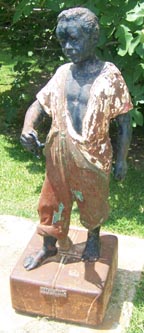
JL Mott
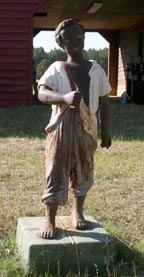
JW Fiske
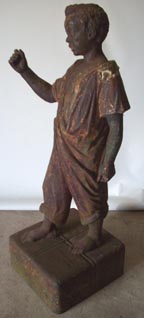
Robert Wood
|
|
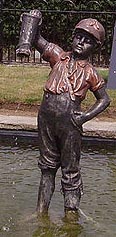 Jocko and Leaky
Jocko and Leaky
While it is not certain that the Faithful Groomsman statue influenced the Statue of Liberty,
there is one famous statue that is almost an exact copy.
In the 1890's, another cast iron statue was made based on the Faithful Groomsman design named Leaky,
or officially "boot boy", or "the boy with the leaky boot". This statue was configured in white-face.
Configured with his left hand in his pocket, 1 strap holding up his trousers, and one pant leg up,
Leaky is a water feature that sprinkles water out of a leaking boot that he is holding in his right hand.
Less than a dozen original "Leakys" exist today, and interest in these rare statues is making
a big comeback due to their value as tourist attractions worldwide.
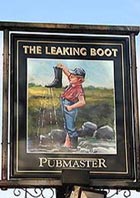
Above: Leaky made famous at pub in England
According to historical records, one Leaky in Stevens Point, Wisconsin was "integrated with a watering trough used by horses".
CLICK HERE to read more about the Stevens Point Leaky statue.
Jocko was also used as a horse "drinking fountain"...
One rare 1800's Faithful Groomsman in Australia was also recently discovered with plumbing cast inside for
a water feature for filling up a horse watering trough... in addition for use as a hitching post.
The water was designed to come out of his mouth.
Jocko-Leaky Hybrids
Some Groomsmen later adopted Leakys "1 pant leg up" style
in the 1950's
|
|
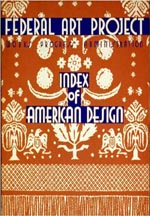 Lawn Jockeys in the Index of American Design
Lawn Jockeys in the Index of American Design
During the Great Depression of the 1930's, artists were employed in a
unique jobs program to draw pictures of unique American-made arts and crafts
and create a catalog and historical record of these items called the Index of American Design.
Below is a 1939 narrative of the project regarding the jockeys entitled
"A Portfolio of Hitching Posts".
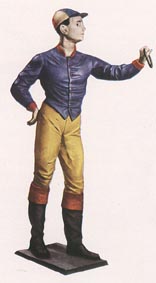 A Portfolio of
A Portfolio of
Hitching Posts
Some day America will look back on what will probably
be known as the "cast iron" period of native crafts.
Already a thing of the past, iron work in the form of
garden ornaments, elaborate architectural decorations and the
like requires only a few more decades to become entirely nostalgic.
One of the chief glories were the variously conceived hitching posts,
without which no home of the 1880's or 1890's
was complete. The Index of American Design, a Federal Art Project
under the Works Progress Administration has included these
in its comprehensive pictoral record of native arts and crafts, and the reproductions
below are from the collection of the Index.
Stove foundries in New Jersey and New York
produced painted cast iron hitching posts like this in the period 1870-1880.
This post is still in use, standing in front of a cigar store in Pasadena,
California. the overall height is 48 1/2" and the rather nicely ornamented
metal base is 15 1/2" square.
Shipped from a foundry in
North Carolina to Lewiston, Idaho about 1879.
Mounted on metal, it stands 26" high.
Records indicate that about 1879 this cast iron hitching post was shipped from Louisiana to
a family in the Middle West. It dates from 1877 or before.
The height is a trifle over three feet.
Many hitching posts such as this, of painted cast iron on a cement
stand, were made in stove foundries throughout the country during the late 19th century.
This one was shipped to California about 1875 and now reposes in the property
department of Warner Brothers.
|
|
|
Lawn Jockey History
1776-1913
We get many questions regarding the origins and rich history of the great American Lawn Jockey statue. Many are surprised to learn that the Lawn Jockey is
actually an evolution of 3 related statues and was used primarily as a horse hitching post in the 1800's. The Lawn Jockey makes history come alive
with legends of tours of duty in the revolutionary war and civil war. Like a time machine, the cultural significance of this unique sculpture has touched
many areas of society in important ways and is still evolving hundreds of years after the statue first appeared.
In this section we will discuss the origins of the 3 versions of the great American Lawn Jockey sculpture in the specific time frame of 1776-1913.
There are 2 distinct historical time frames associated with this statue:
1. 1776-1913: Original versions manufactured of SOLID iron or zinc and weighing approximately 300-400 lbs. designed for FUNCTIONAL use(tying up horses).
2. 1913-present: Reproductions of the statue manufactured of HOLLOW iron(about 150 lbs.), concrete, plastic, or aluminum designed for DECORATIVE use.
This 1911 photo shows two solid cast iron jockeys used as hitching posts at the curb of a cobblestone street in Charleston, SC.
The man is sitting on the stepping stone used for getting in and out of horse drawn carriages stopping by.
Above is a page from JW Fiske's 1910 catalog. Note that there were other jockey
versions other than the 3 main versions. Fiske's "Chinaman" version can be seen in the Charleston, SC photo above(the jockey on the left).
There were hundreds of iron foundrys making jockeys in the 19th century but the 3 biggest manufacturers
that had catalogs and marked their products were JW Fiske and JL Mott of New York City, and Robert Wood and Company
of Philadelphia. The makers mark was usually stamped on the top of the base as shown below.
The "big 3" manufacturers all made the 2 jockey versions as shown below
in the 1902 JL Mott catalog. The "caricature" jockey version was not cataloged or manufactured by the "big 3".
Jockeys were mainly used for residential applications in the 1800's, but also were used for trades as well.
Although they eventually were most closely associated with motels and restaurants as a symbol of "welcome" in the 1900's,
their main location/purpose in the 1800's were to identify tobacco shop storefronts. Historical documents
from manufacturers show zinc statues were made for the trade/tobacco shop applications, while iron statues were made for residences.
Hospitality - Horseracing - History
"Welcome home", "horseracing", and "history" are the 3 primary themes of all lawn jockey statues, reflecting charming memories of a bygone era.
Many other themes are represented in this uniquely American statue, some of which are described here and on other pages on this website:
patriotism, George Washington, the American revolution,
slave participation in the revolutionary war, Greek influences in American art and architecture, the Statue of Liberty,
Christmas, the Underground Railroad, Black Americana, ironwork and the industrial revolution, 19th century American iron toys,
forgotten black jockeys of the 1800's, the Kentucky Derby, southern hospitality, the American centennial, and the American Red Cross.
 Imagine travelling back in time to 1872... clipclopping along the cobblestone road and slowly passing by the gas lights, and then stopping off your horse drawn carriage at the Composite Iron Works, 9 Mercer St., New York City... to pick out a hitching post!
Imagine travelling back in time to 1872... clipclopping along the cobblestone road and slowly passing by the gas lights, and then stopping off your horse drawn carriage at the Composite Iron Works, 9 Mercer St., New York City... to pick out a hitching post!
History of the Lawn Jockey 1776-1913 is still a work in progress- if you have any documents, images, or other information referring to these statues during this time period, especially prior to 1860, please
contact us.
Documented history on the Lawn Jockey is solid back to the 1850's, but prior history is based on
putting pieces of a puzzle together through eyewitness accounts, legend, and speculation.
The trail of puzzle pieces traces the history of the Lawn Jockey back through the civil war in the 1860's to the Underground Railroad in the 1850's, and all the way back to George Washington in 1776.
But to truly understand the origins of the Lawn Jockey statue, you must first turn the time machine clock back further still, way back to 500 bc in ancient Greece where the public display of the human form in sculpture was perfected.
In 500 bc, the ancient greek sculptors perfected statues of the human form...
clothing on sculpture is used to convey social structure.
The jockey's timeless design was borrowed from ancient Greece and reinvented in colonial America.
Above left: Possibly the original jockey design- "Idolino"(500bc) by the famous greek sculptor Polycleitos.
Above center: Statue of the greek god "Apollo"(460bc) riding a chariot that duplicated the Idolino design.
Above right: Another greek statue of Apollo(400bc) holding horses reins while riding a chariot.
Apollo was the greek god of light and the sun, and his
hand is outstretched to hold the reins of his horses to guide his golden chariot as it "rides across the sky" during the day, illuminating the earth.
Many copies of this popular design were made all the way through the end of the Roman Empire in 476ad.
Note how all had bare feet and had their right arm extended to hold horses reins just like the original jockeys.
Apollo was also linked with oracles associated with wishing to know the outcome of an illness.
Healing belonged to Apollo's realm: he was the father of Asclepius, the god of medicine.
2 milleniums later, the American Red Cross was established in the US. Coincidentally, a red jockey looks like a red cross.
Many doctors who made house calls by horsedrawn carriage in the 1800's had red jockey hitching posts at their own homes
to identify their profession. The unusual huge popularity of jockeys in the medical community still continues today in the tradition of Apollo and the Red Cross.
Below left: "Kritos Boy"(500 bc) sculpture,
an example of "contrapposto", a term that describes the weight shift of the torso
producing a relaxed and more natural look. Below center: Slave boy with lantern helping master, 300 bc.
Below right: Possibly the actual Greek-inspired Roman bronze statue from 50ad that inspired the first Jocko(note the facial expression).
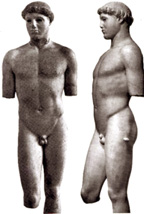
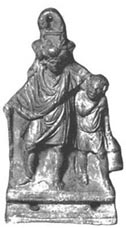
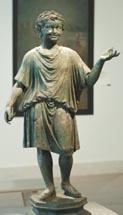 The classical design elements of the Lawn Jockey sculpture, the function for holding horses reins, and the "light-providing" theme were copied from the Greeks, with just the clothing changed
to match the current era.
The classical design elements of the Lawn Jockey sculpture, the function for holding horses reins, and the "light-providing" theme were copied from the Greeks, with just the clothing changed
to match the current era.
Now let's fast forward to 1776, on the eve of the American revolution, where the Lawn Jockey legend began.
Beginning as oral tradition, in the 1960's and 70's the source material for this legend was eventually
published in book and theater play form by Washington DC insurance agent Earl Koger(see play cover below) and in news articles by Washington Post reporter Chester Hampton.
CLICK HERE to read Chester Hampton's newspaper article on September 27, 1970.
At 3am on December 26, 1776 George Washington's colonial army in Pennsylvania crossed the Delaware river and attacked the British at Trenton, New Jersey.
Legend has it Washington's groomsman, a 12-year-old slave boy named Jocko Graves, stayed on the Pennsylvania shore taking care of Washington's horses, holding up a lantern
to mark the location. In 1776, a "groomsman" referred to "a man or boy in charge of feeding, conditioning, and stabling of horses."
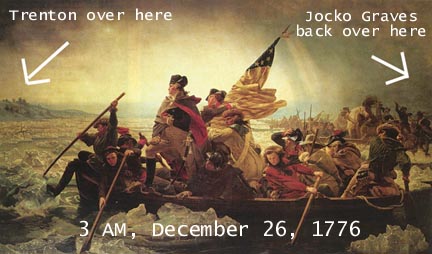 Famous painting of Washington's "Christmas Day" crossing of the Delaware
Famous painting of Washington's "Christmas Day" crossing of the Delaware
Recorded history documents two colonial army deaths in the Battle of Trenton, which was a significant victory for the colonials.
Both soldiers froze to death on the river crossing, not killed in combat.
But legend tells of one more casualty... Jocko, who was found frozen to death on the Pennsylvania shore while still holding the lantern when
Washington returned at noon on December 26, 1776. Legend has it that upon Washington's return to his Mount Vernon, Virginia home, he was so inspired by Jocko's heroism, he commissioned a
cast iron statue of Jocko holding a lantern and called it the "Faithful Groomsman". The "welcome/coming home" theme of these statues started here, and with an ironic double meaning:
"coming home" being also used as a metaphor for "dying and going to heaven" from Christian theology. The last name "Graves" associated with the statue also offers a cryptic allusion
to a cemetary grave- was the original statue a grave marker for Jocko? Taking into account that very few slaves had last names in colonial America, the grave marker explanation seems plausible.
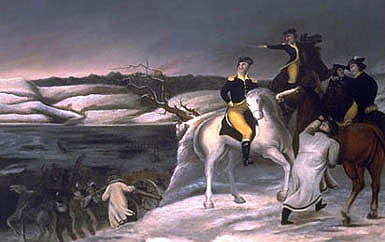
One eyewitness account documents there may have been a "third man" there that night... was Jocko the "third man"?
ABOVE: 1776 letter excerpt by Lt. Col. George Weedon describing "no more than 3 privates" killed at the Battle of Trenton.
CLICK HERE to read Weedons full letter.
Although Christmas was not an elaborate celebration at the time,
the "Christmas" theme of the Jockey also started here... making Jockey statues with lanterns the first "Christmas Lights". Even today, more Jockeys are sold
at Christmas than at any other time.
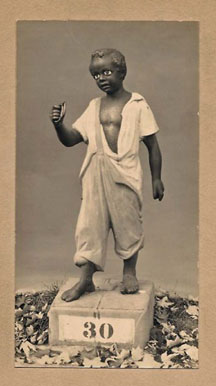
ABOVE: Jockey Christmas greeting card from 1935.
Click on photo for larger view
Lantern, lantern
Burning bright
In our Jockey's
Hand tonight,
Like the shining
Christmas star
Guiding shepherds
From afar,
Lead some weary
Traveler here,
That he may share
Our Christmas cheer
Dressed in his festive attire, the jockey has a unique and profound symbolic double meaning at Christmastime.
As a hitching post, he can be seen as symbolizing a shepherd(groomsman) tending his sheep(Washington's horses).
As a statue holding a lantern, he can be seen as holding the "guiding light" like the north star for kings coming
to Bethlehem(Washington crossing the Delaware).
CLICK HERE to read more about the history of the lawn jockey lantern.
Another incredible Christmas irony of the jockey statue is that the same American iron forges in Kenton, Ohio that manufactured the jockeys
also developed the world's largest iron toy industry in the late 1800's creating America's modern-day "gift-giving" tradition around the time Santa Claus first appeared
in the 1890's.
CLICK HERE to read more about how jockeys helped build the world's largest toy factory in the 19th century.
One can imagine that little Jocko would have been proud that the legacy of his heroic death on banks of the Delaware river that frozen Christmas night and subsequent immortality as a statue would lead
directly to spreading Christmas joy to future generations of children.

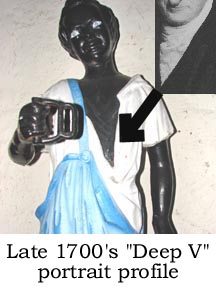 The earliest version of the Lawn Jockey, the original "Faithful Groomsman" would have probably looked like the replica above. Also, notice the many "jocko" features in the famous 1796 Gilbert Stuart full-length "Lansdowne" portrait of Washington.
The painting is full of symbolism, CLICK HERE for details, but the meaning of Washingtons outstretched arm is still a mystery.
Did the painter get his composition
idea from the statue in Washington's lawn? Conversely, note that the deep "V" chest profile on the statue is in the style of an actual 1700's portrait or sculpture- a strong indicator that the statue identifies a real person: Jocko Graves.
The earliest version of the Lawn Jockey, the original "Faithful Groomsman" would have probably looked like the replica above. Also, notice the many "jocko" features in the famous 1796 Gilbert Stuart full-length "Lansdowne" portrait of Washington.
The painting is full of symbolism, CLICK HERE for details, but the meaning of Washingtons outstretched arm is still a mystery.
Did the painter get his composition
idea from the statue in Washington's lawn? Conversely, note that the deep "V" chest profile on the statue is in the style of an actual 1700's portrait or sculpture- a strong indicator that the statue identifies a real person: Jocko Graves.
As Washington was a big hero and trendsetter in the 1770's, many patriots would have copied the statue
for their own homes, mostly in the south where the horse farms were and a black groomsman statue would not seem out of place.
Washington's Mount Vernon mansion was, and still is 200 years later, the most copied home style in the US, so it would not be surprising to find a statue from the home being widely copied as well.
Moreover, Washington's favored architectural style was Greek(see his city plan for Washington, DC), so a Greek-inspired statue would fit in perfectly. Mount Vernon also had a blacksmith shop on site that could have forged the statue.
It would be hard to envision another reason for the "Faithful Groomsman" statue's subsequent popularity other than because of Washington's endorsement.
The whereabouts of the original statue are unknown- it may be in someone's basement somewhere... but may be discovered someday!
Although there is no existing record of the statue at Mount Vernon, much of the estate was altered and dismantled by the time the current owners, the Mount Vernon Ladies’ Association, took over the property in 1858.
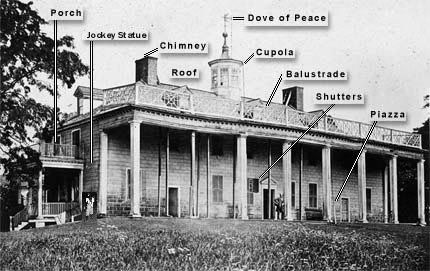 This is how Mount Vernon, which faces the Potomac river, might have looked with a jockey statue on the side facing the river.
Did Washington's memorial statue of Jocko Graves help visitors arriving by boat locate Mount Vernon at night?
The logic would be that a statue holding a lantern overlooking the Potomac River would appear just like
Jocko holding the lantern across the Delaware river during the Battle of Trenton.
This is how Mount Vernon, which faces the Potomac river, might have looked with a jockey statue on the side facing the river.
Did Washington's memorial statue of Jocko Graves help visitors arriving by boat locate Mount Vernon at night?
The logic would be that a statue holding a lantern overlooking the Potomac River would appear just like
Jocko holding the lantern across the Delaware river during the Battle of Trenton.
In an ironic twist, in the 1850's and 60's, in the same deep south where the statues were most popular, Faithful Groomsmen were used to point the way to freedom north along Harriet Tubman's "Underground Railroad" for runaway slaves, a network of "safe houses" protecting escaping slaves from
slave hunters.
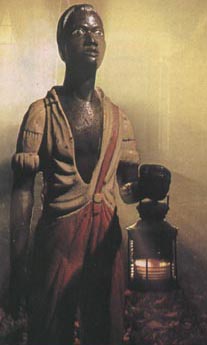
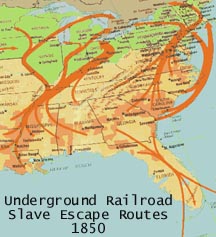 A Civil War "Statue of Liberty" for oppressed slaves...
A Civil War "Statue of Liberty" for oppressed slaves...
According to oral tradition, if no slave hunters were near, the sympathetic agent lit Jocko's lantern or tied a bright cloth to his arm to signal "welcome".
Without this sign, fugitive slaves hid elsewhere until the coast was clear, or moved on to the next safe house.
HISTORICAL NOTE: One of the source documents regarding this legend was published in the Springfield (Ohio) News-Sun of November 20, 1949 about the UGRR station at the Piatt residence and depicts the caricature version of Jocko holding a flag to signal "welcome".
CLICK HERE to read the article.
Also, some stories cite Jocko having "red" and "green" lights or fabric, but this is incorrect, as this "red-stop/green-go" concept was not
invented until the early 1900's- 60 years after the Underground Railroad.
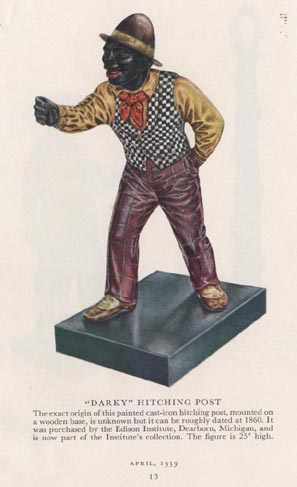 During the 1930's depression, unemployed artists were hired by the government to paint drawings of important American artworks to preserve images
for future generations in a project called the Index of American Design. Included in the historical compilation were several jockeys, including
the one above from the Dearborn, Michigan Edison Institute(now Greenfield Village) dating to 1860. This image supports the Jocko/Underground Railroad legend
showing that jockeys of the style documented in the Piatt story did in fact exist at the time. See the left column of this page for more jockey drawings
from the Index of American Design project.
During the 1930's depression, unemployed artists were hired by the government to paint drawings of important American artworks to preserve images
for future generations in a project called the Index of American Design. Included in the historical compilation were several jockeys, including
the one above from the Dearborn, Michigan Edison Institute(now Greenfield Village) dating to 1860. This image supports the Jocko/Underground Railroad legend
showing that jockeys of the style documented in the Piatt story did in fact exist at the time. See the left column of this page for more jockey drawings
from the Index of American Design project.
Up until around 1860, there was probably only 1 version of the Lawn Jockey, the "Faithful Groomsman". However, after 1860, 2 new versions emerged.
Coming online at the start of the American industrial revolution, these new statues
would have been the first to be mass-produced.
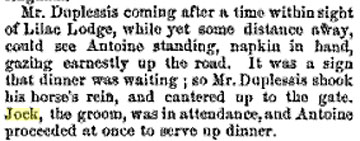 Excerpt from Saturday Reader, August 25, 1866 mentioning Jock the groom at the gate of a southern plantation.
Excerpt from Saturday Reader, August 25, 1866 mentioning Jock the groom at the gate of a southern plantation.
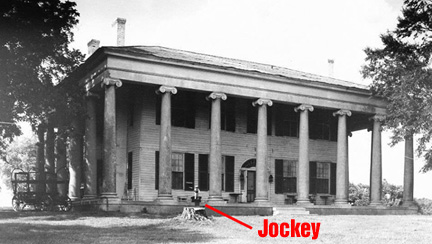 1935 photo of a plantation in Florence, Alabama that was built in the 1830's.
1935 photo of a plantation in Florence, Alabama that was built in the 1830's.
The first new version was the "Picaninny Caricature" version of Faithful Groomsman, complete with bulging eyes, wide mouth, and big red lips. The idea for the version was possibly inspired by Topsy or Uncle Tom,
characters in Harriet Beecher Stowe's 1852 popular novel "Uncle Tom's Cabin". Later "Picaninny Caricatures" from books and movies like Sambo(1890's- with blue pants and a red top) and Buckwheat(1920's) kept the Groomsman Caricature version popular for decades.
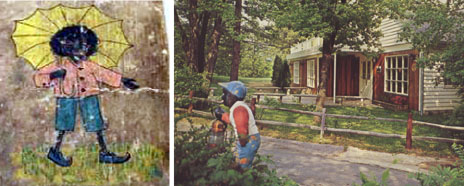 Helen Bannerman's 1897 children's book "The Story of Little Black Sambo" sparked a fad in Faithful Groomsman statues painted with blue trousers and red shirt. On left, illustration from book- on right, postcard of Fairfield Hall, Boiling Springs, PA(built 1785) showing Jocko statue painted in early 1900's Sambo theme.
Helen Bannerman's 1897 children's book "The Story of Little Black Sambo" sparked a fad in Faithful Groomsman statues painted with blue trousers and red shirt. On left, illustration from book- on right, postcard of Fairfield Hall, Boiling Springs, PA(built 1785) showing Jocko statue painted in early 1900's Sambo theme.
The influence of Jocko Graves' story on American literature and pop culture
Jocko Graves' heroic deed to help a white protagonist(George Washington) "get out of trouble" represents one of the first uses of a "Magical Negro" character in American fiction which still influences
story and script plot structure today. CLICK HERE for other "magical negros" in American pop culture.
After the second "Jocko" groomsman came the "Lawn Jockey" version of the statue, which was based on the Faithful Groomsman caricature, originally depicted in black-face, but as an adult and configured as a "horse racing jockey".
The "Lawn Jockey" sculpture was copyrighted in 1871 and patented in 1872. Both "Faithful Groomsman" versions were never copyrighted or patented, adding to the mystery of their origins.
The "Picaninny Caricature" version of Faithful Groomsman, although physically distorted, actually gives the
best linear connection to the Legend of Jocko Graves.
Speculation is that an unknown sculptor made the picaninny reproduction of the Faithful Groomsman from a verbal or written description only,
but without actually seeing the original statue itself.
First note the 1860's-style "Jockey Cap" and facial features additions, as if the sculptor was told the subject was a young slave boy named "Jocko" who cared for Washington's horses, so he combined both jockey and picaninny details on Jocko's head.
Next note the fancy vest and tie clothes addition, as if he was perhaps told Jocko was also a "wedding groom". The unique hand-in-pocket addition is very important in that it clearly illustrates that the sculptor
was told that Jocko was out in the cold and "froze to death" as in the legend.
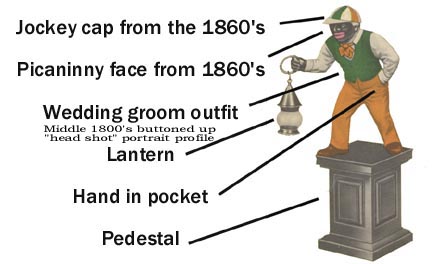 The 1860's Caricature version clearly reflects the original intent of the statue. However, the clothes
style does not match the 1700's and are unsuitable for a Jockos character as a stable hand/groomsman.
The 1860's Caricature version clearly reflects the original intent of the statue. However, the clothes
style does not match the 1700's and are unsuitable for a Jockos character as a stable hand/groomsman.
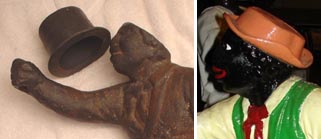 The Caricature version was cast in 2 parts, the hat and the body. The "jockey
style" cap was by far the most popular on hollow replicas cast after 1910-
there were several period hats used on the original solid hitching posts.
The Caricature version was cast in 2 parts, the hat and the body. The "jockey
style" cap was by far the most popular on hollow replicas cast after 1910-
there were several period hats used on the original solid hitching posts.
The final version of the statue, the Lawn Jockey, is the horse racing jockey statue that most people are familiar with... these are the Original Jocks on this page:
CLICK HERE to go to the ORIGINAL JOCKS
The "horse racing jockey" was originally patented on May 21, 1872 by Robert Wood and Company of Philadelphia, PA.
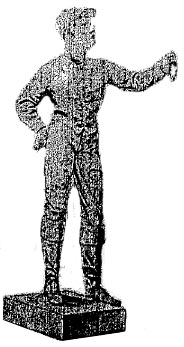
CLICK ON PHOTO ABOVE TO SEE THE ORIGINAL 1872 PATENT!
The actual term "Lawn Jockey" is fairly recent- originating in the 1940's. Older terms used to describe this version of the statue include "jockey lawn ornament", "jockey boy", "jockey statue", and "jockey hitching post".
Original Jocks combine both the history of the statue(but deleting the distinctive African-American features) along with adding unique new design elements based on ancient Greek "contrapposto",
making this version a timeless classic. Painting options on Original Lawn Jocks are almost unlimited due
to the design of the sculpture with it's repeating lines and forms. The Original Lawn Jock is a
perfectly blended collection of artistically designed round and angular shapes.
Note that following Greek tradition, the statue is not anatomically correct(for example- the left arm is shorter than the right arm).
The human form is balanced and relaxed- the Original Lawn Jock was designed as a real metal art sculpture for your yard! Adding the pedestal is the most important feature in all Lawn Jockey statues
because it describes the character as being memorialized in a position of high regard or adoration, on a pedestal, like a war hero... like Jocko Graves.
ORIGINAL JOCKEY PAINTING SCHEMES
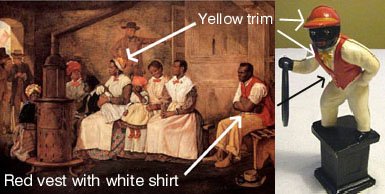
Jockeys have been painted and repainted in many different colors and patterns. All were originally black-face, but since they were
all outside and their iron skin eventually corroded, all we have to go by in determining their original
clothes colors are paintings of the era, statuettes and miniature salesmans samples.
1860 FAITHFUL GROOMSMAN CARICATURE VERSION
The antibellum painting above shows a group of "household" slaves. From 1860 to about 1900, the red-yellow-white configuration depicting
Jocko as a "house negro" was probably his original color scheme. After 1900, more caricature versions adopted a red-white-blue theme(see Sambo book details above).
1776 FAITHFUL GROOMSMAN VERSION
This is the hardest configuration to determine since the originals were not mass produced, and none has be found conclusively dating to before the 1850's.
However, this sculpture is clearly depicted in 1700's-1800's "field negro/stablehand" couture and paintings of the era indicate that a blue-white painting scheme would have been correct(see antibellum painting of slave picking cotton below).
Also, JW Fiske of New York, who were aesthetically correct in their reproductions(see left column), manufactured this Jocko version in the blue-white configuration in the 1860's.
1871 LAWN JOCKEY VERSION
From paintings and statuettes, we know the most likely configuration of the original version of this sculpture depicting a horseracing jockey
was in a paint scheme with red(with possibly some yellow trim) on top and white on the bottom(consistent with all horseracing outfits dating back to the
1800's).
1913: The end of the Lawn Jockey era?
Below: New York Times obituary of the Lawn Jockey on July 20, 1913.
Cause of death: the American automobile industry.
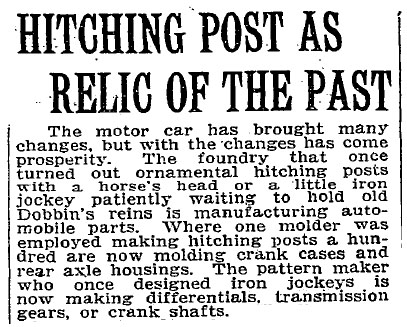
CLICK ON ARTICLE TO READ MORE
This 1913 forecast proved accurate as cars did indeed take over the road. But alas, quoting Mark Twain, reports of the Lawn Jockey's demise were premature. America's love for these charming iron hitching posts proved just too
strong to discard them on the junkpile of history. The timeless design of the iconic Lawn Jock and Horse Hitching Post lived on... and STILL lives on at this site and at HORSEHITCHES.COM.
How ironic is it that 100 years after this Lawn Jockey obituary was written, now it is the great American automobile industry that is on its deathbed... and the great American Lawn Jock and Horse Hitching Post are making a big comeback!
One final important concept gleened from the story of George Washington and the history of Jockey statues is
that the statues:
1) Are deemed to depict an actual unique individual through their paint scheme, not like generic animals
2) Are traditionally only presented individually- they are rarely presented as "matching pairs" like lions or "groups" like gnomes.
If two are nearby, usually either a different statue style or paint scheme is used.
A single "faith"-ful groomsman statue symbolizes in religious and patriotic terms the faith in the individual... "the power of one" that is the foundation
of American freedom and democracy. This is the enduring "spirit of '76" in each and every Jockey. Jocko Graves himself may have never seen freedom, but his "painted eyes"
have witnessed the history and progress of America as his torch has passed from generation to generation.
In the end, the validity of the Jocko Graves story and Underground Railroad legend may be secondary in importance to the historical significance and cultural influence of the Lawn Jockey statue itself.
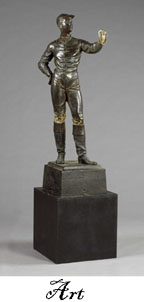
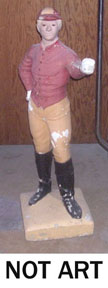 Only high quality real forged metal Jocks from the original balanced greek-inspired classical design, on pedestals, are timeless works of art. The paint is glossy and shiny. Art and history are reflected accurately and positively.
Only high quality real forged metal Jocks from the original balanced greek-inspired classical design, on pedestals, are timeless works of art. The paint is glossy and shiny. Art and history are reflected accurately and positively.
Low quality cheap concrete and plastic-molded replicas are unbalanced, and have no art value. The paint is faded, dull and flakes off.
Art and history are poorly presented.
|
|
|
LAWN JOCKEY HISTORY CONTINUES...
ON YOUR STOOP...
WITH A REAL METAL LAWN JOCKEY
FROM LAWNJOCK.COM!
|
|
|



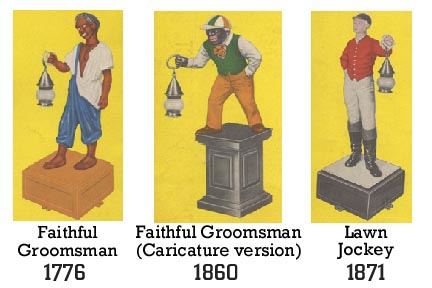




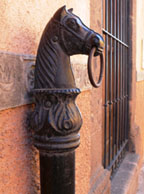

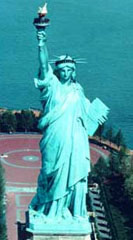





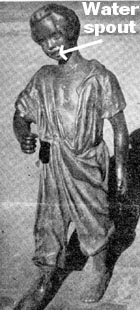


 A Portfolio of
A Portfolio of